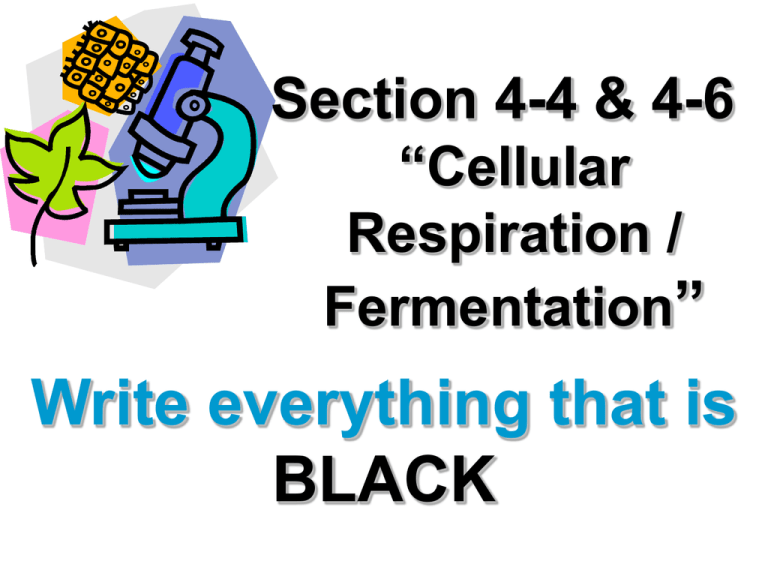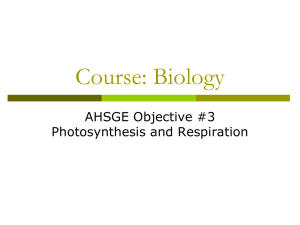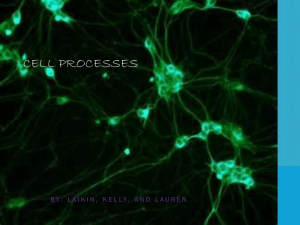Cellular Respiration / Fermentation
advertisement

Section 4-4 & 4-6 “Cellular Respiration / Fermentation” Write everything that is BLACK 4.4 Cellular Respiration / 4.6 Fermentation 4.4 KEY CONCEPT The overall process of cellular respiration converts sugar into ATP using oxygen 4.4 Cellular Respiration / 4.6 Fermentation Cellular respiration makes ATP by breaking down sugars. • Cellular respiration is aerobic (requires oxygen) • It happens in the mitochondria mitochondrion animal cell 4.4 Cellular Respiration / 4.6 Fermentation • Glycolysis must take place first. – anaerobic process (does not require oxygen) – takes place in cytoplasm – splits glucose into two three-carbon molecules – produces two ATP molecules 4.4 Cellular Respiration / 4.6 Fermentation Cellular respiration is like a mirror image of photosynthesis. • The Krebs cycle transfers energy to an electron transport chain.Krebs1 Cycle – takes place in mitochondrial matrix – breaks down three-carbon molecules from glycolysis – makes a small amount of ATP – releases carbon dioxide – transfers energy-carrying molecules mitochondrion ATP matrix (area enclosed and by inner membrane) 6CO 2 energy 2 3 energy from glycolysis and 6O2 inner membrane ATP and 6H2 O 4 4.4 Cellular Respiration / 4.6 Fermentation • The electron transport chain produces a large amount of ATP. – takes place in inner 1 membrane – energy transferred to electron transport Electron Transport chain 3 – oxygen enters process and 6O – ATP produced energy from glycolysis 2 –water released as a waste product mitochondrion matrix (area enclosed by inner membrane) ATP and 6CO2 energy 2 inner membrane ATP and 6H2 O 4 4.4 Cellular Respiration / 4.6 Fermentation • The equation for cellular respiration: C6H12O6 + 6O2 6CO2 + 6H2O • The reactants in photosynthesis are the same as the products of cellular respiration. 4.4 Cellular Respiration / 4.6 Fermentation 4.6 KEY CONCEPT Fermentation allows the production of a small amount of ATP without oxygen. 4.4 Cellular Respiration / 4.6 Fermentation • Fermentation allows glycolysis to continue making ATP when oxygen is unavailable. • Fermentation is an anaerobic process – occurs when oxygen is not available for cellular respiration – does not produce ATP 4.4 Cellular Respiration / 4.6 Fermentation • Lactic acid fermentation occurs in muscle cells – glycolysis splits glucose into two pyruvate molecules – pyruvate and NADH enter fermentation – energy from NADH converts pyruvate into lactic acid – NADH is changed back into NAD+ 4.4 Cellular Respiration / 4.6 Fermentation • Alcoholic fermentation is similar to lactic acid fermentation • Fermentation is used in food production. –yogurt –cheese –bread 4.4 Cellular Respiration / 4.6 Fermentation Pages 5, 6, & 7 1. Page 5 Title this page Cellular Respiration -What is the function of cellular respiration? -What is the difference between aerobic and anaerobic? -Which of the above does cellular respiration require? -What does the kreb cycle do? -What does the electron transport chain do? 2. Page 6 Title this page COMPARING PROCESSES -On page 115 draw figure 4.12 and under each drawing write the equation that fits the drawing 4.4 Cellular Respiration / 4.6 Fermentation 3. Page 7 Title this page Fermentation -Write the key concept for fermentation Which type of process is fermentation? What does that term mean? -Describe the difference between Lactic acid fermentation and alcoholic fermentation. -Give 3 examples of alcoholic fermentation








